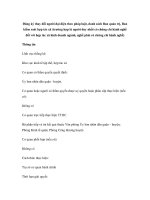SLIDE - Quản trị bán lẻ, bán sỉ và hậu cần thị trường potx
Bạn đang xem bản rút gọn của tài liệu. Xem và tải ngay bản đầy đủ của tài liệu tại đây (470.4 KB, 21 trang )
©2003 Prentice Hall, Inc. To accompany A Framework for Marketing Management, 2
nd
Edition Slide 0 in Chapter 15
Chapter 15Chapter 15
Quản trị bán lẻ, bán sỉ và Quản trị bán lẻ, bán sỉ và
hậu cần thị trườnghậu cần thị trường
©2003 Prentice Hall, Inc. To accompany A Framework for Marketing Management, 2
nd
Edition Slide 1 in Chapter 15
Mục tiêuMục tiêu
Xác định các kiểu tổ chức trong
lĩnh vực này.
Tìm hiểu những quyết định
marketing nào được thực hiện
trong lĩnh vực này.
Hiểu những xu hướng chính trong
lĩnh vực này.
©2003 Prentice Hall, Inc. To accompany A Framework for Marketing Management, 2
nd
Edition Slide 2 in Chapter 15
Bán lẻBán lẻ
Các vấn đề về bán lẻ
Các kiểu nhà bán lẻ
Các quyết định
marketing
Các xu hướng bán
lẻ
Chu kỳ sống bán lẻ
Vòng quay bán lẻ
Các mức độ dịch
vụ
Các chiến lược
định vị bán lẻ
Bán lẻ không tồn
kho
Tổ chức bán lẻ
©2003 Prentice Hall, Inc. To accompany A Framework for Marketing Management, 2
nd
Edition Slide 3 in Chapter 15
Bán lẻBán lẻ
Cửa hàng chuyên
dụng
Cửa hàng bách
hóa
Siêu thị
Cửa hàng chiết
khấu
Cửa hàng tiện
dụng
Nhà bán lẻ giá rẻ
(Off-price)
Cửa hàng lớn
Các kiểu nhà bán lẻ quan trọng
©2003 Prentice Hall, Inc. To accompany A Framework for Marketing Management, 2
nd
Edition Slide 4 in Chapter 15
Bán lẻBán lẻ
Các loại cửa hàng bán lẻ trải qua các
giai đoạn của chu kỳ sống.
Chu kỳ sống của bán lẻ mô tả những
loại cửa hàng mới ra đời như thế
nào.
Các nhà bán lẻ có thể cung ứng một
trong bốn mức dịch vụ sau:
– Tự phục vụ, tự lựa chọn, dịch vụ hạn
chế và dịch vụ trọn gói
©2003 Prentice Hall, Inc. To accompany A Framework for Marketing Management, 2
nd
Edition Slide 5 in Chapter 15
Bán lẻBán lẻ
Bốn chiến lược định vị bán lẻ bao
gồm:
– Bloomingdale’s
– Tiffany
– Sunglass Hut
– Wal-Mart
Bán lẻ không qua cửa hàng tăng
trưởng nhanh hơn bán lẻ qua cửa
hàng
©2003 Prentice Hall, Inc. To accompany A Framework for Marketing Management, 2
nd
Edition Slide 6 in Chapter 15
Bán lẻBán lẻ
Corporate
chain store
Voluntary
chain
Retailer
cooperative
Consumer
cooperative
Franchise
organization
Merchandising
conglomerate
Các loại tổ chức bán lẻ quan trọng
©2003 Prentice Hall, Inc. To accompany A Framework for Marketing Management, 2
nd
Edition Slide 7 in Chapter 15
RetailingRetailing
Retailing Basics
Types of retailers
Marketing
decisions
Retailing trends
Target market
Product assortment
and placement
Services mix and
store atmosphere
Price
Promotion
Place
©2003 Prentice Hall, Inc. To accompany A Framework for Marketing Management, 2
nd
Edition Slide 8 in Chapter 15
RetailingRetailing
General business
district
Regional
shopping center
Community
shopping center
Strip mall
(shopping strip)
Location within a
larger store or
operation
Location Options for Retailers
©2003 Prentice Hall, Inc. To accompany A Framework for Marketing Management, 2
nd
Edition Slide 9 in Chapter 15
RetailingRetailing
Retailing Basics
Types of retailers
Marketing
decisions
Retailing trends
New retail forms
Intertype competition
Growth of giant
retailers
Technology
Global expansion
Selling experiences
Competition between
store-based and non-
store-based retailing
©2003 Prentice Hall, Inc. To accompany A Framework for Marketing Management, 2
nd
Edition Slide 10 in Chapter 15
WholesalingWholesaling
Wholesaling
Wholesaling basics
Types of
wholesalers
Marketing decisions
Wholesaling trends
Wholesaling excludes
manufacturers, farmers,
and retailers
Wholesalers differ from
retailers in three key
ways
Wholesalers handle
many functions more
efficiently than do
manufacturers
©2003 Prentice Hall, Inc. To accompany A Framework for Marketing Management, 2
nd
Edition Slide 11 in Chapter 15
WholesalingWholesaling
Selling and
promoting
Buying and
assortment
building
Bulk breaking
Warehousing
Transportation
Financing
Risk bearing
Market information
Wholesaler Functions
©2003 Prentice Hall, Inc. To accompany A Framework for Marketing Management, 2
nd
Edition Slide 12 in Chapter 15
WholesalingWholesaling
Wholesaling
Wholesaling basics
Growth and types
of wholesalers
Marketing decisions
Wholesaling trends
Wholesalers vary in type
and function
Wholesaling has been
growing due to two key
factors:
– Many factories are located
far from buyers
– An increasing need to
adapt product quantities,
features, or packages to
meet buyer needs
©2003 Prentice Hall, Inc. To accompany A Framework for Marketing Management, 2
nd
Edition Slide 13 in Chapter 15
WholesalingWholesaling
Merchant
wholesalers
Full-service
wholesalers
Limited-service
wholesalers
Brokers & agents
Brokers
Agents
Manufacturers’ and
retailers’ branches
and offices
Miscellaneous
wholesalers
Major Wholesaler Types
©2003 Prentice Hall, Inc. To accompany A Framework for Marketing Management, 2
nd
Edition Slide 14 in Chapter 15
WholesalingWholesaling
Wholesaling
Wholesaling basics
Types of
wholesalers
Marketing decisions
Wholesaling trends
Target market
Product assortment
and placement
Price
Promotion
Place
©2003 Prentice Hall, Inc. To accompany A Framework for Marketing Management, 2
nd
Edition Slide 15 in Chapter 15
WholesalingWholesaling
Wholesaling
Wholesaling basics
Types of
wholesalers
Marketing decisions
Wholesaling trends
Direct buying trends
initially threatened
wholesalers
Wholesalers have
adapted by:
– Adding value
– Reducing costs
– Strengthening
relationships with
manufacturers
©2003 Prentice Hall, Inc. To accompany A Framework for Marketing Management, 2
nd
Edition Slide 16 in Chapter 15
Market LogisticsMarket Logistics
Interrelated Aspects Associated with
Market Logistics:
– Physical distribution
– Supply chain management (SCM)
– Value network
– Demand chain planning
– Market logistics
– Integrated logistics systems (ILS)
©2003 Prentice Hall, Inc. To accompany A Framework for Marketing Management, 2
nd
Edition Slide 17 in Chapter 15
Market LogisticsMarket Logistics
Key Elements
Market-logistics
objectives
Market-logistics
decisions
Market logistics
lessons
Logistics involve trade-
offs between costs and
customer service
Maximizing profits, not
sales, is key
A total system basis
should be considered
Designing a system that
will minimize the cost of
achieving objectives
should be the outcome
©2003 Prentice Hall, Inc. To accompany A Framework for Marketing Management, 2
nd
Edition Slide 18 in Chapter 15
Market LogisticsMarket Logistics
M = T + FW + VW + S
Where . . .
M = total market-logistics cost of proposed system;
T = total freight cost of proposed system;
FW = total fixed warehouse cost of proposed system;
VW = total variable warehouse cost of proposed system
S = total cost of lost sales due to average delivery delay
Calculating the Cost of
Market-Logistics Systems
©2003 Prentice Hall, Inc. To accompany A Framework for Marketing Management, 2
nd
Edition Slide 19 in Chapter 15
Market LogisticsMarket Logistics
Key Elements
Market-logistics
objectives
Market-logistics
decisions
Market logistics
lessons
Order processing
Warehousing
– Storage, distribution,
automated warehouses
Inventory
– Determine reorder point,
relevant cost comparison,
optimal order quantity
Transportation
– Containerization
– Private vs. contract
carriers
©2003 Prentice Hall, Inc. To accompany A Framework for Marketing Management, 2
nd
Edition Slide 20 in Chapter 15
Market LogisticsMarket Logistics
Key Elements
Market-logistics
objectives
Market-logistics
decisions
Market logistics
lessons
A senior V.P. is needed
as the single contact
point for all logistical
elements
Senior V.P. must
maintain close control
Software and systems
are essential for
competitively superior
logistics performance







